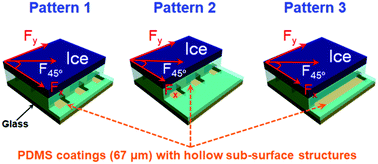Understanding the role of hollow sub-surface structures in reducing ice adhesion strength
Abstract
The accretion of ice on exposed surfaces results in detrimental effects in many aspects of life and technology. Passive icephobic coatings, designed by strategies towards lowering ice adhesion to mitigate icing problems, have recently received great attention. In our previous studies, incorporation of hollow sub-surface structures which act as macro-scale crack initiators has been shown to drastically lower the ice adhesion on PDMS surfaces. In this study, the effects of hollow sub-surface structure geometry, such as the heights, shapes, and distributions, as well as the directions of the applied shear force, are experimentally investigated. Our results show that the number of potential macro-scale crack initiation sites dictates ice adhesion strength. The directions of the applied shear force also influence the ice adhesion strength when the potential crack length is dependent on the applied shear force direction. The inter-locking effect between ice and the coating, caused by the pre-deformation, needs to be considered if one of the dimensions of the hollow sub-surface structures approaches the millimeter scale. These results improve the understanding of the role of hollow sub-surface structures in reducing ice adhesion, providing new insights into the design principles for multi-scale crack initiator-promoted icephobic surfaces.



 Please wait while we load your content...
Please wait while we load your content...